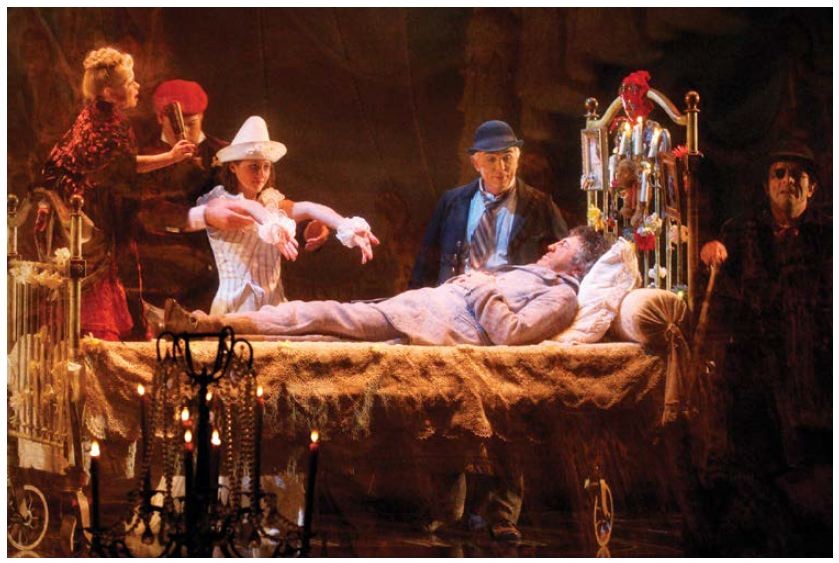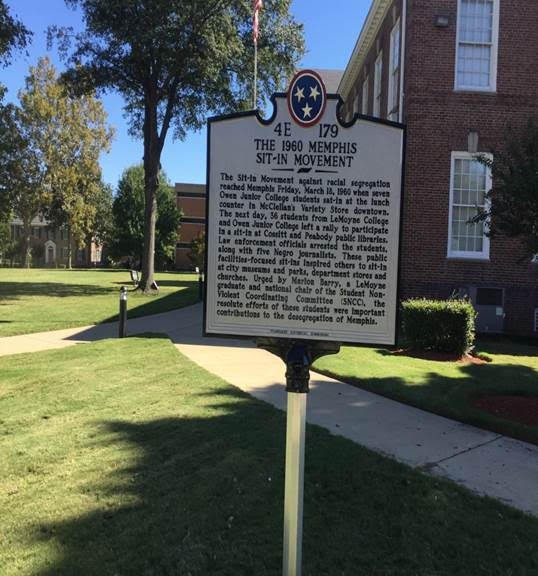
Thirty-five years after its inception, most Americans are so familiar with the work of Cirque du Soleil that it’s become a cliche. Which is surprising, given the troupe’s penchant for constant reinvention. Moreover, the cliche doesn’t account for the broad diversity of musical genres used in their various productions. Last night’s Memphis premiere of Cirque du Soleil’s Corteo was a reminder of just how powerful their music can be.
If any Cirque music is famous, it is the soundtrack to their Beatles tribute, Love. which relied on Giles Martin’s startlingly imaginative mash ups of familiar Beatles tracks. Naturally, that music was all pre-recorded. So casual theatergoers (arena-goers?) might not be anticipating the power of Corteo‘s live band.
The show is ostensibly a cross between a circus and a funeral, beginning with our protagonist Mauro lying in repose on his deathbed, or perhaps dreaming of that moment. If Mauro was a clown in life, here he is bereft of greasepaint or costumes, rising from the bed in his plain suit to wistfully guide us through kinetic tableaux from his life. There is no narrative as such; rather, we take a tour through moments of his youth rather like the globe-trotting vignettes of The Nutcracker. And, like that classical chestnut, an air of slightly threadbare Old World pageantry permeates every scene. 
The same aesthetic colors the music. While much of Cirque music tends toward a fantasy/futurist/New Age vibe, Corteo’s sounds, to their credit, are more grounded in Old World earthiness. Much of the lyrics are Italian, with sprinklings of Spanish, Portugese, and French (and a bit of English dialogue and joke-cracking). The somewhat nostalgic sounds are carried off with aplomb by the live band in the wings.
And the band lives in a plurality of wings, not an orchestra pit. The two-sided stage, set down in the center of the FedEx Forum, has band members tucked into four corners: the drummer here, the singer and accordionist there, here the bass, there the horns. That they can stay so perfectly in sync is surely a miracle of click-track sorcery, yet the unabashedly sentimental music flows like water, or tears.
Cirque du Soleil’s Corteo : Old World Circus Melodies Take Flight
It can range from intimate nostalgia to grandiose operatic melodies. Yes, there’s more than a hint of Broadway here, but the chief departure from the music of European salon and folk idioms comes when the Cirque composers show their true postmodern colors, with bits of Brazilian samba and even Tibetan harmonic bowls making an appearance. 
Mozart meets Tibetan bowls in a scene from Corteo
Some of the most surprising musicianship comes from the onstage performers. This goes beyond moments when, say, the drummer leaps from behind his alcove to play a snare alongside the acrobats and dancers, underscoring their every feat. Mauro himself appears in one scene playing a tuba. The recurring White Clown character, it turns out, is also a consummate violinist; and the ringmaster is revealed as a virtuoso whistler of Mozart. Most alarmingly, the woman who twines herself in hanging fabrics, making death-defying drops and rolls, is, through her athletic breathing, singing the entire time.
In the end, this is show music, of course, and much of it serves to accentuate the movement, which remains the star attraction. Yet this can be rather powerful, when the band swells to every sudden lifting of angels in flight. Furthermore, accompanying mid-air twirls and hairs’-breadth escapes from danger may be one of the best uses of prog rock imaginable.
Finally, if you’re contemplating making this a family outing, I should note that our freshly minted 15-year-old, more accustomed to the cool, guarded sounds of Lorde, thoroughly enjoyed this Old World melody-laden musical experience. 
The musicians featured in this staging of Corteo include:
BAND LEADER – Roger HEWETT (United Kingdom)
VIOLIN – Stéphane ALLARD (Canada)
BASS/CONTRABASS – Robert BRENNAN (USA)
MALE SINGER – Alain LABRIE (Canada)
FEMALE SINGER – Aurélie DEROUX-DAUPHIN (France)
SAX/KEYBOARD 2 – Philippe POIRIER (Canada)
DRUMS/PERCUSSION – Alexandre REIS (Brazil)
GUITAR/ACCORDION – Eve WILLEMS (Belgium)







